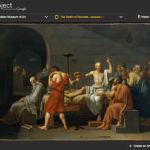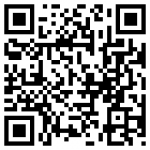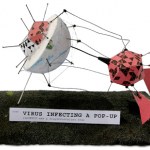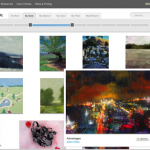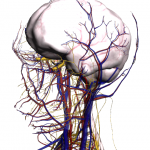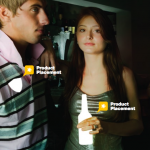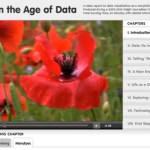Web 2.0, New Media, and Gadgets
So lately I've been trying to understand open source licensing options for software code, which is hard, because I'm not a coder. (If I don't understand an xkcd, it's almost always because it's some sort of Python joke.)
Anyway, Michael Ogawa made some videos a few years back depicting the growth of various projects (Python, Apache) as various developers came on board and committed code to the pool. His Python video is fascinating; it starts in 1991 with Guido van Rossum, who slowly attracts other developers. Through 2000, you can easily watch individual participants come in and out of the…
Remember the synthetic biology documentary I blogged about a while back? Well, the filmmakers are still working toward their goal. They have a little less than a month left, and I just noticed that they've seriously beefed up the rewards you can get for funding them. There are some interesting gifts from $10 up, but now at $300$1000*, they will send you a rough cut, solicit your input, and credit you in the final version. For everyone concerned about how scientists appear in the film, this is an intriguing option!
*Correction -the cost is actually $1000. For some reason Kickstarter bins all…
Experiencing late-afternoon unproductivity? Go play with Google Art Project and virtually tour the world's museums.
Update: NYT review.
An invitation from scienceforcitizens.net:
As record levels of snow blanket much of the United States this year, Science For Citizens is collaborating with an important climate research project at the University of Waterloo called Snow Tweets. We're pleased that this is the first of many scientific projects that you'll be able to do on Science for Citizens.
To help researchers track climate change, we're requesting that you find a ruler, put on a warm coat, go outside, and measure the depth of snow wherever you happen to be. And then report the depth to us right here. That's all there is to…
I think DNA is amazing. I think biotech inspires great design. And if you've read this blog at all, you know I love sciart. But I just cannot understand the new infogenetics product from DNA 11 - the company behind that trendy gel electrophoresis wall art. While I'd normally just say "I don't get it" and move on, DNA 11 claims that their "augmented art" is "the ultimate intersection of biology, art and technology." I don't know how that could get more squarely in the BioE wheelhouse. So let's take a closer look at how, exactly, biology and art intersect in the "Ancestry Portrait" (pictured…
From NextNature, an intriguing post about the Institute for Digital Biology:
During the exhibition, visitors were able to feed a colony of microscopical pop-up creatures, save Chinese websites from a pageview-shortage, preserve an Amazone tribe from extinction by subscribing to its homepage and view a short documentary on how the living internet established itself.
Artist Walewijn den Boer also created a peculiar, twelve-minute faux-documentary, which uses animation to bring his digital biology concepts into meatspace (check it out below the fold).
Update 1:
I think the clunkiness of the…
I got a very nice email today from Sam Gaty, one of the filmmakers behind the Synthetic Biology Documentary I blogged about earlier. He acknowledged the "mad scientist" type concerns, but emphasized that's not what they're going for in the final documentary, and suggested I share another short clip. This one is far more, I don't know how to describe it, techno-chic?
I can definitely see that sort of presentation getting kids interested in biology. It spins bench science as something intriguing, cutting edge, maybe a little hipster. Framing really is all in the aesthetics, isn't it?
Check…
So I'm all in favor of promoting struggling artists, and that includes documentary filmmakers. But I have to say I'm a little taken aback by the aesthetic of the "Synthetic Bio" documentary project by Field Test Films (and endorsed by Carl Zimmer). They've posted a short over at Kickstarter, where they're trying to raise $30K to finish the film in time for Sundance. But as one of my biologist friends pointed out, the soundtrack they use for the sample short (on producing spider silk in goat's milk) is eerie, mad-scientist stuff, complete with a Exorcist-like choir at the end.
I'm posting the…
TurningArt is a startup that lets you make a queue of prints by various independent artists, try the prints out in your home or office, and exchange them as often as you like. After you've lived with the print long enough, you can trade it in for the original canvas, watercolor or collage; you just pay the balance of the original's cost (and your subscription fees count as credit toward the purchase price).
Check out how it works, below the fold. . .
Easy, right? (As an artist, my anxieties are greatly allayed by the fact that they're shipping prints around in those tubes, not the…
A new biology game called EteRNA "crowdsourc[es] the scientific method" by inviting players to design their own self-folding RNAs. The best designs are synthesized and tested in the lab to see how well the predicted structure plays out in the physical world - an innovation the game's creators see as an improvement over other folding games like Foldit, where there is no experimental feedback.
"Putting a ball through a hoop or drawing a better poker hand is the way we're used to winning games, but in EteRNA you score when the molecule you've designed can assemble itself," said one of the PIs…
Here are some essay links I've had open as tabs in my browser for over a week, waiting to be posted. Unfortunately, I don't have time to do the extensive commentary they deserve, so I'm admitting that, and just posting them already. Enjoy.
Graphical Abstracts & Biologists as Designers
Andrew Sun discusses "graphical abstracts" at nature network:
Although they are irrelevant to the quality of the research in my opinion, graphical abstracts (GAs) are in fact increasingly appreciated nowadays. No matter you like them or not, chances are that you have to draw one in order to publish your…
Because people have been discussing Google ngrams a lot, and because there are always major caveats to new datamining methodologies, I have to link Natalie Binder's excellent series of posts urging caution, not only about the methodology, but about assuming too much about ngrams' utility in social research.
Binder says,
The value of the Ngrams Viewer rests on a bold conceit: that the number of times a word is used at certain periods of time has some kind of relationship to the culture of the time. For example, the fact that the word "slavery" peaks around 1860 suggests that people in 1860…
Google Labs just released a new "experiment" - Body Browser. You have to upgrade to Google Chrome beta if you don't already have it, but when you do, you can play with a 3-D, rotatable reconstruction of a (female) human body. Sliders let you fade the circulatory, skeletal, muscular, and nervous systems in and out over the body organs; you can toggle labels on and off, and you can zoom, spin, and rotate in a way that would only be cooler if it were on a touchscreen iPad. (Yeah, that's what I said, Google. Do it!) Check out this screenshot:
Toggle a few sliders and you can wrap the vessels and…
FYI:
Science Art-Nature and the American Association for the Advancement of Science (AAAS) present the "Science Without Borders" online art exhibition in conjunction with the annual meeting of the American Association for the Advancement of Science, Washington, D.C., February 17 - 21, 2011.This on-line art exhibition, was conceived to display and promote the best contemporary Science Art and to encourage discourse between the scientific and artistic communities. Designed as a companion to the national meeting of the American Association for the Advancement of Science, each selected piece of…
The New York Times decided earlier this week that biological animation warrants its own article. About time! :)
Seriously, for those of you who haven't discovered BioVisions' amazing animations, you should check them out and/or use them in class - with the caveat that they're not "pure" data:
While acknowledging the potential to help refine a hypothesis, for example, some scientists say that visualizations can quickly veer into fiction. "Some animations are clearly more Hollywood than useful display," says Peter Walter, a Howard Hughes Medical Institute investigator at the University of…
IBM has a new commercial depicting the constant streams of medical biodata that can be gathered from a human body, and hopefully improve healthcare. In a shameless play to elicit warm fuzzies, they made it about very young babies:
Awwwww. With all the glowing data, it's sort of like a baby TRON. And what's with the virtual-data-baby-mobile? Is it made of giant diatoms, or what?
Wait. . . I know what this reminds me of. . . it's a PLANKTON PARTY!
BTW, there's also a "behind the scenes" clip of the IBM commercial, with the apparent sole purpose of giving the babies extra cute camera time.…
For health organizations, federal agencies and nonprofits alike, it's a challenge to get anyone to pay attention long enough to hear your prevention messages, much less to actually change their behavior as a result. It's even harder with kids. It's not that they don't care about science; quite the contrary, they love it - especially if it's gross. It's more that they don't want to hear an authority figure talking down to them about the parade of terribles that will befall them if they binge drink, have unprotected sex, etc. Be honest: can you think back to your high school health classes…
Knight Fellow Geoff McGhee created this polished video documentary series about how data visualization is infiltrating and transforming journalism. Interviews with Many Eyes creators Fernanda Viegas and Martin Wattenberg, Amanda Cox of the New York Times, and other dataviz luminaries are coupled with bios and links to further information, some history of visualization techniques, industry context (is dataviz profitable? who's doing it?) and lots of lovely examples. The last section of the video, "First Steps," is a mini-tour of useful DIY sites like Swivel and Wordle (which is ridiculously…
This is what I miss out on by not reading the physical copy of the New York Times: ads! I recently picked up a copy of the Times science section and saw an ad for these wonderful vintage patent office models from the 1900s.
As if they're not steampunky enough, each one comes with a little yellowed, handwritten, calligraphic tag that I'm dying to read because I am convinced it must contain cryptic clues to some sort of awesome Neil Stephenson-style mystery. Right??
My friend Shana mentioned this one to me: it's an LED sculpture that opens at night and folds closed during the day, like a light-sensitive flower. The creator, Wendy Legro, says: "The sun is our natural light source. Our homes are filled with artificial light replacing it, undeliberately disrupting our biological clock. This product works autonomously with a light sensor. During the day, mechanical flowers are closed enabling sunlight to come in. When sun sets, the flowers open and start to emit light. In this way, awareness for a beautiful phenomenon will be brought back."
I'm not usually…
